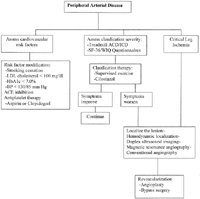Critical Leg Ischemia in Peripheral Arterial Disease
The initial management of patients with critical leg ischemia involves pain relief including narcotics. Patients with more severe disease including ischemic ulceration or gangrene also need wound care to control infection and prevention of further trauma to the extremity. Specific medical treatments for critical leg ischemia have been limited. Numerous trials have been performed in Europe using prostaglandin drugs. These trials have met with marginal success using a variety of agents. Antiplatelet therapy is critical to maintain graft patency, whereas the use of anticoagulation to maintain graft patency is empiric and done only in selected cases.
Definitive evaluation and management requires arteriography and revascularization, or primary amputation. Revascularization operations for critical limb ischemia use the patient’s own veins (greater saphenous, lesser saphenous, and arm veins) as the optimal bypass conduit.
Current 5-year patency rates for below-knee popliteal (distal anastomosis to a modest-sized artery just below the knee) and tibial (distal anastomosis to smaller arteries at the calf level or below) bypass of 60% to 70% and 50% to 60%, respectively, have been reported by multiple centers. Limb salvage (prevention of amputation) rates of 80% or better for the same time interval are also the rule, which is due to success in second bypass surgeries when the first operation eventually fails. Operative mortality is 5% in most series but may reach 10% in patients over 80 years of age. Hospital stays of 10 or more days are common due to slow healing and frequent complications and comorbidities. About one-quarter to one-third of patients need to go to some sort of rehabilitation facility on discharge, although the majority will stay for only a few weeks. The decision to use surgery or angioplasty as the initial treatment option follows the TASC guidelines described earlier.
Despite these impressive patency data, 23% of bypasses will need some sort of operative revision (usually within the first year) to repair a stenotic area that develops in the vein graft. Twenty percent of patients will require at least one readmission for wound care issues, usually associated with an operative incision. The majority of patients develop significant lymphedema in the operated leg. Constant graft ultrasound surveillance to locate the asymptomatic stenoses before graft occlusion and limb threat (every 3 months for the first year and every 6 months for life) and potential revision needs lead to a substantial amount of patient anxiety.
In patients who progress to amputation, below-knee amputations are performed in patients with ambulatory potential. However, despite many different techniques, there is no guaranteed method to assure healing of below-knee amputations. Issues that complicate healing include poor circulation, chronic edema, and skin changes consistent with chronic venous disease. This difficulty is reflected in a reamputation rate to attempt below-knee salvage from 4% to 30%. Importantly, half of all below-knee amputees who fail primary healing ultimately require above-knee amputation. Primary above-knee amputation is considered the best option for patients without any ambulatory potential (dementia, stroke, obesity, etc).
More below-knee amputees achieve ambulation than above-knee amputees, although overall the number of major amputees who achieve meaningful independent ambulation is small. Initial rehabilitation can require 9 months or longer. By 2 years, 30% of amputees who were walking are no longer using their prostheses. Advanced age and female gender bode poorly for ambulation. Fifteen percent of amputees require contralateral amputation, and another 20% to 30% have died by 2 years.
An overall approach to the treatment of PAD is presented in Figure 41.2.
Figure 41.2. Evaluation and treatment of patients with proven Peripheral arterial disease. All patients with Peripheral arterial disease, regardless of symptom severity, should undergo risk factor modification to achieve the listed treatment goals and receive antiplatelet drug therapy with aspirin, but clopidogrel is an acceptable alternative drug. Angiotensin-converting enzyme inhibitors should be considered because of the potential for prevention of ischemic events that is independent of blood pressure lowering. A treadmill test to define the absolute claudication distance (ACD) and the initial claudication distance (ICD) can provide an objective assessment of the severity of claudication and response to therapy. The functional limitations of claudication and response to therapy can also be quantified by the physical function scales of the nondisease-specific Medical Outcomes Short Form 36 questionnaire (SF-36) and the disease-specific Walking Impairment Questionnaire (WIQ). Treatment of claudication should begin with exercise therapy or drugs such as cilostazol. Patients who do not improve and remain disabled, or who have worsening symptoms, should have additional localization of the occlusive lesions to plan endovascular or surgical intervention. Noninvasive disease localization can be done with hemodynamic tests such as segmental limb pressures or pulse volume recordings. In addition, duplex ultrasound and magnetic resonance angiography (MRA) both have a high sensitivity and specificity for localization of lesions (with MRA having the highest sensitivity), but conventional angiography is still required in most patients before a surgical or angioplasty procedure. Patients with critical leg ischemia typically have an ankle-brachial index less than 0.40 and should initially be considered for localization of their occlusive disease in anticipation of the need for revascularization.
